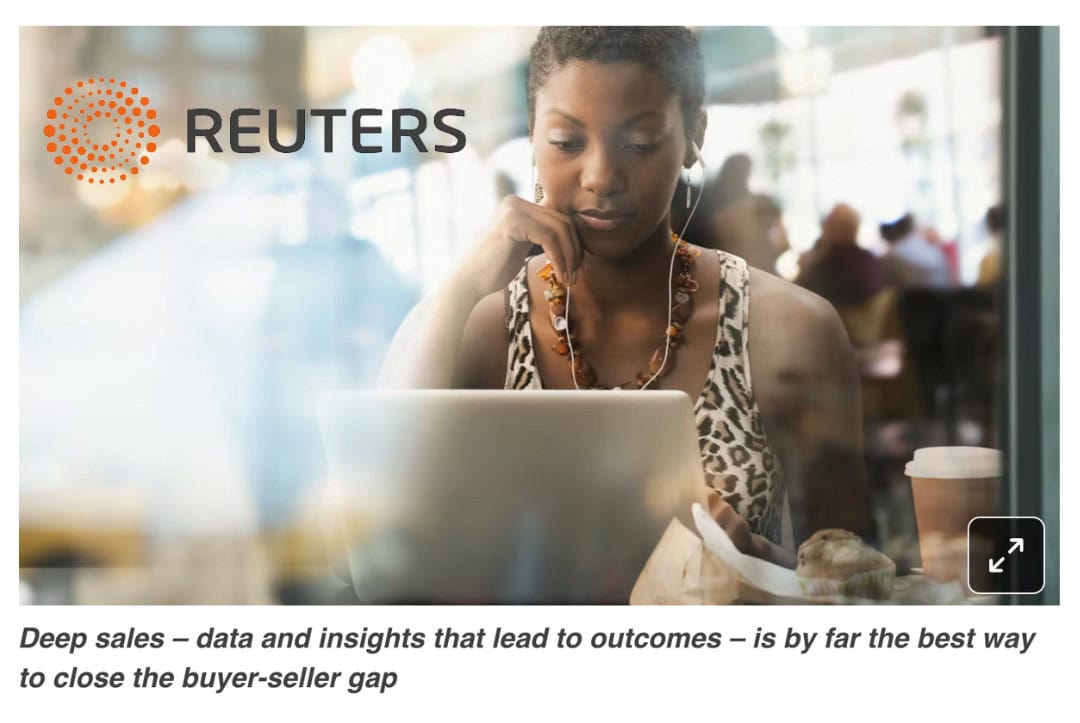Bold Brand Ideas: Ditch Mass Outreach + Embrace B2B Micro-Moments: Targeting the Right Message at the Right Time
Deep sales strategies are taking off as cold outreach and traditional sales tactics flounder.
A core component of deep sales is intimately knowing your buyers and understanding their priorities. It requires insight into things like nagging pain points, trending topics and common questions. Once you have this understanding, you can build digital PR strategies that put key messages where and when they matter most.
Using PR to connect brands with micro-moments is an effective sales tactic when rooted in solving, not selling. Tapping micro-moments isn’t meant to be self-serving. It’s about positioning yourself as a resource – even before the buying process starts – so you’re a top consideration when the time is right.
Example micro-moments could be…
- “Which is best?”: An operator needs to upgrade equipment after a refrigerator unexpectedly breaks. In that moment, they may search for product specifications or reviews. For example, “commercial kitchen equipment reviews.” This is a “Which is best?” moment where the buyer is comparing multiple solutions. During this time, you want search engine results to populate trusted roundups that include your product. You want the operator to scroll through social media and see your product used or endorsed by their favorite influencers.
- “I need help”: A VP of sales is noticing a decline in qualified leads. They’re recognizing traditional strategies aren’t working anymore and need ideas for elevating their team’s approach. This “I need help” moment is when they’re likely to search online for best practices, trends or experts who have novel takes. You want your executive to be positioned as a thought leader in prominent trade publications or LinkedIn news.
- “I want to innovate”: A chef may search for new ingredients that will attract Gen Z diners. These “I want to innovate” moments are driven by the need to stay ahead of trends. They may go to peers for inspiration or lean on industry trend reports and credible news sources.
These micro-moments create a golden opportunity for brands to insert themselves into the buyer’s journey – without seeming intrusive or “salesy”. They’re far more powerful than an unsolicited email.
Brands that anticipate these moments and serve up relevant solutions move from passive players to top contenders in a buyers’ consideration set.
What this looks like in practice:
- Develop a content strategy with key messages and value-adds specific to every stage of the buyer’s journey. Invest time in developing key messages that clearly and compellingly position your company as a solution to pressing business challenges. These messages should be tailored for each of your targets, at each stage of their buying journey.
- Be prepared to “newsjack” trending topics. As macro trends bubble up, develop a unique POV and share it with trade publications likely covering the topic. If you know certain times of year bring specific challenges, pitch novel solutions or hot takes to those problems. Use case studies or proprietary data points to support how your company helped solve challenges during these moments.
Ensure PR content aligns with the sales funnel. Collaborate with marketing and sales teams to ensure that PR content (e.g., media placements, thought leadership and interviews) feeds into the broader content ecosystem. The most compelling sales outreach is tailored outreach. Empower your sales teams with resources that address likely pain points, providing value.
Remember: solve don’t sell.
Industry Insights: Use AI to Elevate Your Thought Leadership with Custom Insights
Artificial intelligence (AI) is reshaping the way marketers gather, analyze and apply data to inform their strategies. With AI’s ability to analyze vast amounts of data quickly and accurately, brands can now gain deeper (and real-time!) insights into buyer behaviors, preferences and emerging trends.
Whether it’s tracking customer journeys across multiple touchpoints or predicting future customer needs, AI offers valuable data that can be leveraged across functions.

Consider these benefits for PR campaigns:
Personifying Your Audience
You can create custom GLMs that personify your target audiences. Once this GLM is set up, you can ask the personas questions about their preferences and needs. You can also ask them for input on key messages, content strategies and thought leadership ideas.
Identifying Trends and Anticipating What’s Next
AI tools can analyze social media, news and reviews to provide valuable insights into audience sentiment. This allows you to stay ahead of emerging trends and align thought leadership content with topics that matter most to consumers. For example, if AI detects growing interest in sustainability within the food service industry, you can proactively position your brand as a leader in this area, addressing concerns before they become mainstream discussions.
Enhancing Media Outreach with Predictive Insights
AI can provide predictive insights by analyzing historical data on media coverage, helping to identify which outlets and journalists are most likely to reply to your pitch. It can also give you ideas for “what’s next” so you can provide journalists with fresh takes and future-cast perspectives.
Content Optimization and Personalization
AI can analyze how different types of content perform across platforms and tailor future content based on audience preferences and engagement metrics. By assessing data like time spent on articles, click-through rates and social shares, AI tools can identify which formats, topics and tones resonate most with your audience – more efficiently. This allows PR teams to continually refine and personalize thought leadership pieces, ensuring that content not only reaches the right people but also keeps them engaged.
How are you using AI? What barriers are you facing?
Goals: Why Building Stronger PR, Marketing and Sales Alignment Drives Revenue
It’s not news that marketing and sales alignment is critical for B2B success:
- B2B organizations that closely align their sales and marketing teams experience 24% faster revenue growth and 27% faster profit growth over a three-year period compared to companies with less alignment (Forrester).
- Aligning your sales and marketing teams can improve your company’s ability to close deals by 67% (Adobe).
- This alignment can result in a 209% increase in revenue generated from marketing efforts (Adobe).
Despite its importance, alignment and the resulting ROI are often hard to achieve. Perhaps the missing piece is PR strategies that connect the dots between storytelling, marketing and sales.
In today’s integrated landscape, the most effective B2B brands are treating PR as a strategic sales enablement tool.
PR plays a direct role in moving leads down the funnel and driving revenue. Coverage and content from PR efforts “warm the waters” and build trust with buyers.
Despite PR’s role in the deep sale (see first section), the reality is 70% of content and coverage aren’t leveraged by sales.
This further emphasizes the need for alignment between sales, marketing and PR. It’s also a reminder for PR teams to prioritize coverage and content that serves all functions.
Here’s how to avoid wasted content and leverage PR for sales enablement:
- Use PR for Nurturing Prospects: Thought leadership through PR is key for building trust with prospects. Have your sales team send relevant press coverage on industry trends or challenges, rather than a product sheet. This positions your business as a credible source here to solve, not sell, further nurturing the relationship.
- Create Consistency in Content Marketing: Ensure your website reflects the coverage prospects see in the media by publishing blogs or landing pages that dive deeper into those topics. Also, highlight PR wins in newsletters and email campaigns. This combination of PR and content marketing reinforces key messages and helps guide prospects through the sales funnel.
- Maximize PR on Social Media and Sales Assets: Encourage your team to share PR wins with personalized social media posts, including key quotes and branded images to drive engagement. Make sharing easy by offering copy options to your sales team. Additionally, display media mentions and awards prominently on your website, sales decks and marketing materials to build instant credibility and trust.
Is PR part of your sales strategy?
DEI Download: How to Further Personalize Your Campaigns with Language Accessibility
Language accessibility is no longer a consideration for marketing campaigns—it’s a strategic necessity, especially when reaching Gen Z – the most diverse and digital generation yet.
Let’s start with a definition. Language accessibility means ensuring content is accessible to individuals of all ages and abilities, including those with disabilities, limited literacy skills and non-native English speakers.
In an era where personalization drives engagement, catering content for unique audiences offers brands a competitive advantage, enhances brand perception and increases reach.
Insight-driven, audience-centric campaigns fall short when accessibility isn’t considered. Consider these initial steps toward language-accessible campaigns:
- Equipping brand websites and mobile apps with multiple language options that are localized depending on where it’s being accessed. For example, Airbnb’s website can support 50+ languages and uses the user’s preferred language as the initial language when a customer first comes to their website.
- Sharing social media content in various languages. For example, Coca-Cola tailors social media campaigns and content by region to deliver content that resonates both linguistically + culturally across different countries. Read more about Coke’s approach.
- Incorporating subtitles and translations in video content. For example, this resource from YouTube shares how to add subtitles and captions to existing videos. You can retroactively and proactively ensure your videos are accessible.
How else does your team ensure accessibility?


